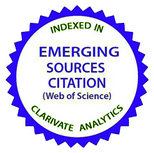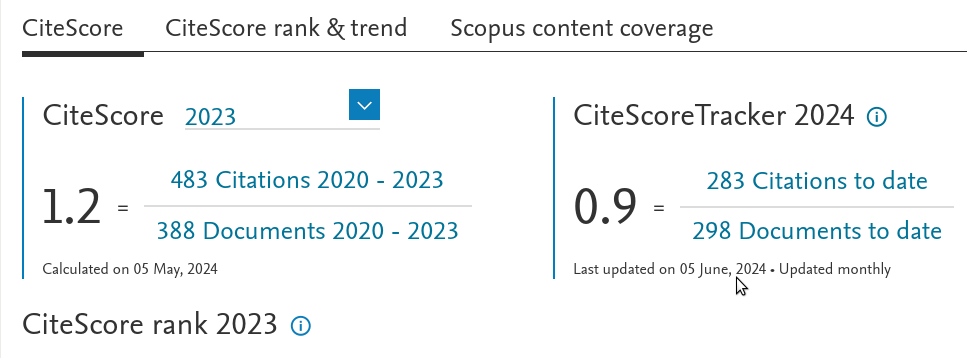Теплопровідність Si нанониток з аморфною SiO2 обо-лонкою: молекулярно-динамічний розрахунок
DOI:
https://doi.org/10.15407/ujpe66.5.399Ключові слова:
коефiцiєнт теплопровiдностi, нанонитка, кремнiй, молекулярна динамiкаАнотація
Методом нерiвноважної молекулярної динамiки дослiджено процеси теплового транспорту в Si нанонитках, покритих оболонкою аморфного SiO2. Розглянуто вплив товщини аморфного шару, радiуса кристалiчного кремнiєвого ядра I температури на величину коефiцiєнта теплопровiдностi нанониток. Встановлено, що збiльшення товщини аморфної оболонки зумовлює зменшення теплопровiдностi Si/SiO2 нанониток типу ядро-оболонка. Результати також показують, що теплопровiднiсть Si/SiO2 нанониток при 300 К зростає зi збiльшенням площi поперечного перерiзу кристалiчного Si ядра. Виявлено, що температурна залежнiсть коефiцiєнта теплопровiдностi Si/SiO2 нанониток типу ядро-оболонка є суттєво слабшою, нiж в кристалiчних кремнiєвих нанонитках. Показано, що така вiдмiннiсть є результатом рiзних домiнуючих механiзмiв фононного розсiювання в нанонитках. Отриманi результати демонструють, що нанонитки Si/SiO2 є перспективним матерiалом для термоелектричних застосувань.
Посилання
Y. Cui, Z. Zhong, D. Wang, W.U. Wang, C.M. Lieber. High performance silicon nanowire fi eld eff ect transistors.
Nano Letters 3, 149 (2003).
https://doi.org/10.1021/nl025875l
Y. He, W. Yu, G. Ouyang. Shape-dependent conversion efficiency of Si nanowire solar cells with polygonal cross-
sections. J. Appl. Phys. 119, 225101 (2016).
https://doi.org/10.1063/1.4953377
M.N. Esfahani, Y. Kilinc, M.C. Karakan, E. Orhan, M.S. Hanay, Y. Leblebici, B.E. Alaca. Piezoresistive silicon nanowire resonators as embedded building blocks in thick SOI. J. Micromech. Microeng. 28, 045006 (2018).
https://doi.org/10.1088/1361-6439/aaab2f
A.K. Katiyar, A.K. Sinha, S. Manna, S.K. Ray. Fabrication of Si/ZnS radial nanowire heterojunction arrays for white
light emitting devices on si substrates. ACS Appl. Mater. Interf. 6, 15007 (2014).
https://doi.org/10.1021/am5028605
Y. Yang, W. Yuan, W. Kang, Y. Ye, Q. Pan, X. Zhang, Y. Ke, C. Wang, Z. Qiu, Y. Tang. A review on silicon nanowire-based anodes for next-generation high-performance lithium-ion batteries from a material-based perspective. Sustain. Energ. Fuels 3, 1 (2020).
https://doi.org/10.1039/C9SE01165J
N.I. Goktas, P. Wilson, A. Ghukasyan, D. Wagner, S. McNamee, R.R. LaPierre Nanowires for energy: A review. Appl. Phys. Rev. 5, 041305 (2018).
https://doi.org/10.1063/1.5054842
F. Dom'ınguez-Adame, M. Mart'ın-Gonz'alez, D. S'anchez, A. Cantarero. Nanowires: A route to effi cient thermoelectric devices. Physica E 113, 213 (2019).
https://doi.org/10.1016/j.physe.2019.03.021
O. Korotchenkov, A. Nadtochiy, V. Kuryliuk, C.-C. Wang, P.-W. Li, A. Cantarero. Thermoelectric energy conversion
in layered structures with strained Ge quantum dots grown on Si surfaces. Eur. Phys. J. B 87, 64 (2014).
https://doi.org/10.1140/epjb/e2014-50074-8
A. Majumdar. Thermoelectricity in semiconductor nanostructures. Science 303, 777 (2004).
https://doi.org/10.1126/science.1093164
A.I. Hochbaum, R. Chen, R.D. Delgado, W. Liang, E.C. Garnett, M. Najarian, A. Majumdar, P. Yang. Enhanced thermoelectric performance of rough silicon nanowires. Nature 451, 163 (2008).
https://doi.org/10.1038/nature06381
J. Chen, G. Zhang, B. Li. A universal gauge for thermal conductivity of silicon nanowires with diff erent cross sectional geometries. J. Chem. Phys. 135, 204705 (2011).
https://doi.org/10.1063/1.3663386
A. Paul, M. Luisier, G. Klimeck. Shape and orientation effects on the ballistic phonon thermal properties of ultra-
scaled Si nanowires. J. Appl. Phys. 110, 114309 (2011).
https://doi.org/10.1063/1.3662177
J.M. Weisse, A.M. Marconnet, D. Kim, P.M. Rao, M.A. Panzer, K.E. Goodson, X. Zheng. Thermal conductivity in porous silicon nanowire arrays. Nanosc. Res. Lett. 7, 554 (2012).
https://doi.org/10.1186/1556-276X-7-554
S. Yi, C. Yu. Modeling of thermoelectric properties of SiGe alloy nanowires and estimation of the best design parameters for high fi gure-of-merits. J. Appl. Phys. 117, 035105 (2015).
https://doi.org/10.1063/1.4906226
M. Royo, R. Rurali. Tuning thermal transport in Si nanowires by isotope engineering. Phys. Chem. Chem. Phys. 18, 26262 (2016).
https://doi.org/10.1039/C6CP04581B
M.G. Shahraki, Z. Zeinali Eff ects of vacancy defects and axial strain on thermal conductivity of silicon nanowires: A reverse nonequilibrium molecular dynamics simulation. J. Phys. Chem. Solids 85, 233 (2015).
https://doi.org/10.1016/j.jpcs.2015.06.001
C.W. Zhang, H. Zhou, Y. Zeng, L. Zheng, Y.L. Zhan, K.D. Bi. A reduction of thermal conductivity of non-periodic Si/Ge superlattice nanowire: Molecular dynamics simulation. Int. J. Heat Mass Transf. 132, 681 (2019).
https://doi.org/10.1016/j.ijheatmasstransfer.2018.12.041
M. Isaiev, O. Didukh, T. Nychyporuk, V. Timoshenko, V. Lysenko. Anisotropic heat conduction in silicon nanowire network revealed by Raman scattering. Appl. Phys. Lett. 110, 011908 (2017).
https://doi.org/10.1063/1.4973737
J.P. Feser, J.S. Sadhu, B.P. Azeredo, K.H. Hsu, J. Ma, J. Kim, M. Seong, N.X. Fang, X. Li, P.M. Ferreira, S. Sinha, D.G. Cahill. Thermal conductivity of silicon nanowire arrays with controlled roughness. J. Appl. Phys. 112, 114306 (2012).
https://doi.org/10.1063/1.4767456
F. Zhuge, T. Takahashi, M. Kanai, K. Nagashima, N. Fukata, K. Uchida, T. Yanagida. Thermal conductivity of Si
nanowires with б-modulated dopant distribution by self-heated 3w method and its length dependence. J. Appl.
Phys. 124, 065105 (2018).
https://doi.org/10.1063/1.5039988
P. Lishchuk, M. Isaiev, L. Osminkina, R. Burbelo, T. Nychyporuk, V. Timoshenko. Photoacoustic characterization
of nanowire arrays formed by metal-assisted chemical etching of crystalline silicon substrates with different doping level. Physica E 107, 131 (2019).
https://doi.org/10.1016/j.physe.2018.11.016
S. Sarikurt, A. Ozden, A. Kandemir, C. Sevik, A. Kinaci, J.B. Haskins, T. Cagin. Tailoring thermal conductivity of
silicon/germanium nanowires utilizing core-shell architecture. J. Appl. Phys. 119, 155101 (2016).
https://doi.org/10.1063/1.4946835
M. Hu, K.P. Giapis, J.V. Goicochea, X. Zhang, D. Poulikakos. Signifi cant Reduction of Thermal Conductivity in Si/Ge Core-Shell Nanowires. Nano Lett. 11, 618 (2011).
https://doi.org/10.1021/nl103718a
X. Liu, G. Zhang, Q. Pei, Y. Zhang. Modulating the thermal conductivity of silicon nanowires via surface amorphization. Sci. Chin. Technolog. Sci. 57, 699 (2014).
https://doi.org/10.1007/s11431-014-5496-2
S. Plimpton. Fast parallel algorithms for short-range molecular dynamics. J. Comput. Phys. 117, 1 (1995).
https://doi.org/10.1006/jcph.1995.1039
J. Tersoff . Modeling solid-state chemistry: Interatomic potentials for multicomponent systems. Phys. Rev. B 39, 5566 (1989).
https://doi.org/10.1103/PhysRevB.39.5566
V. Kuryliuk, S. Semchuk. Molecular dynamics calculation of thermal conductivity in a-SiO2 and an a-SiO2-based nanocomposite. Ukr. J. Phys. 61, 835 (2016).
https://doi.org/10.15407/ujpe61.09.0835
V.V. Kuryliuk, O.A. Korotchenkov. Atomistic simulation of the thermal conductivity in amorphous SiO2 matrix/Ge nanocrystal composites. Physica E 88, 228 (2017).
https://doi.org/10.1016/j.physe.2017.01.021
F. M¨uller-Plathe. A simple nonequilibrium molecular dynamics method for calculating the thermal conductivity. J. Chem. Phys. 106, 6082 (1997).
https://doi.org/10.1063/1.473271
C.J. Glassbrenner, G.A. Slack. Thermal conductivity of silicon and germanium from 3 K to the melting point. Phys. Rev. 134, A1058 (1964). https://doi.org/10.1103/PhysRev.134.A1058
T. Zushi, K. Ohmori, K. Yamada, T. Watanabe. Effect of a-SiO2 layer on the thermal transport properties of (100)
Si nanowires: A molecular dynamics study. Phys. Rev. B 91, 115308 (2015).
M. Hu, X. Zhang, K.P. Giapis, D. Poulikakos. Thermal conductivity reduction in core-shell nanowires. Phys. Rev. B 84, 085442 (2011). https://doi.org/10.1103/PhysRevB.84.085442
Downloads
Опубліковано
Як цитувати
Номер
Розділ
Ліцензія
Ліцензійний Договір
на використання Твору
м. Київ, Україна
Відповідальний автор та співавтори (надалі іменовані як Автор(и)) статті, яку він (вони) подають до Українського фізичного журналу, (надалі іменована як Твір) з одного боку та Інститут теоретичної фізики імені М.М. Боголюбова НАН України в особі директора (надалі – Видавець) з іншого боку уклали даний Договір про таке:
1. Предмет договору.
Автор(и) надає(ють) Видавцю безоплатно невиключні права на використання Твору (наукового, технічного або іншого характеру) на умовах, визначених цим Договором.
2. Способи використання Твору.
2.1. Автор(и) надає(ють) Видавцю право на використання Твору таким чином:
2.1.1. Використовувати Твір шляхом його видання в Українському фізичному журналі (далі – Видання) мовою оригіналу та в перекладі на англійську (погоджений Автором(ами) і Видавцем примірник Твору, прийнятого до друку, є невід’ємною частиною Ліцензійного договору).
2.1.2. Переробляти, адаптувати або іншим чином змінювати Твір за погодженням з Автором(ами).
2.1.3. Перекладати Твір у випадку, коли Твір викладений іншою мовою, ніж мова, якою передбачена публікація у Виданні.
2.2. Якщо Автор(и) виявить(лять) бажання використовувати Твір в інший спосіб, як то публікувати перекладену версію Твору (окрім випадку, зазначеного в п. 2.1.3 цього Договору); розміщувати повністю або частково в мережі Інтернет; публікувати Твір в інших, у тому числі іноземних, виданнях; включати Твір як складову частину інших збірників, антологій, енциклопедій тощо, то Автор(и) мають отримати на це письмовий дозвіл від Видавця.
3. Територія використання.
Автор(и) надає(ють) Видавцю право на використання Твору способами, зазначеними у п.п. 2.1.1–2.1.3 цього Договору, на території України, а також право на розповсюдження Твору як невід’ємної складової частини Видання на території України та інших країн шляхом передплати, продажу та безоплатної передачі третій стороні.
4. Строк, на який надаються права.
4.1. Договір є чинним з дати підписання та діє протягом усього часу функціонування Видання.
5. Застереження.
5.1. Автор(и) заявляє(ють), що:
– він/вона є автором (співавтором) Твору;
– авторські права на даний Твір не передані іншій стороні;
– даний Твір не був раніше опублікований і не буде опублікований у будь-якому іншому виданні до публікації його Видавцем (див. також п. 2.2);
– Автор(и) не порушив(ли) права інтелектуальної власності інших осіб. Якщо у Творі наведені матеріали інших осіб за виключенням випадків цитування в обсязі, виправданому науковим, інформаційним або критичним характером Твору, використання таких матеріалів здійснене Автором(ами) з дотриманням норм міжнародного законодавства і законодавства України.
6. Реквізити і підписи сторін.
Видавець: Інститут теоретичної фізики імені М.М. Боголюбова НАН України.
Адреса: м. Київ, вул. Метрологічна 14-б.
Автор: Електронний підпис від імені та за погодження всіх співавторів.

















